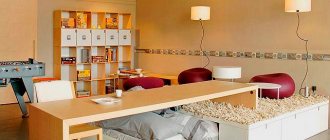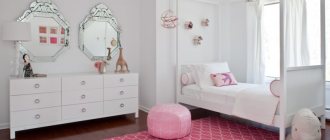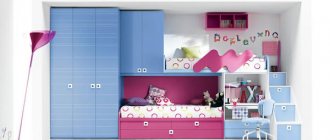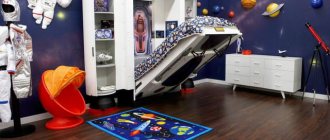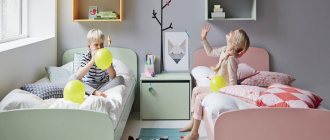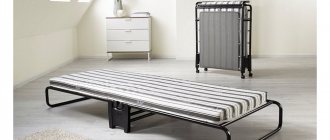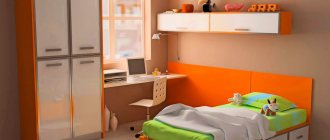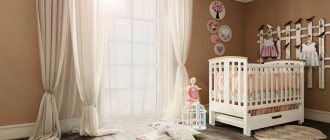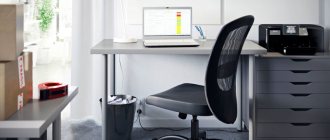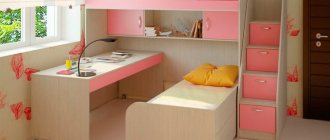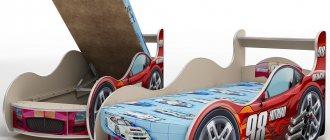Parents approach arranging a sleeping place for a child very responsibly, but in the process of choosing a bed they often reach a dead end. The most difficult question is deciding on the size of the bed. In this case, the following points are important:
- The size of the bed and the size of the sleeping place are different concepts;
- The bed must be suitable for the child according to his physical characteristics;
- The bed should not “eat up” all the usable space in the children’s room;
- The current age of the child and the period for which the bed will be used are important.
Now let's look at these nuances in more detail.
Bed and sleeping area size
The sleeping area is the area of the bed where the child will sleep. The size of the sleeping place is equal to the size of the mattress. Moreover, the bed itself can be much larger. This is especially true for designer products - beds in the shape of cars, ships, carriages, etc. Such products will require more space and should be combined with the interior of the room.
Advice (not entirely on topic). It is worth realizing that small and childishly decorated beds, especially cartoon-themed ones, give joy for only a few years, and then the child himself gets bored. Don’t forget about growing up: if at the age of 5-6 your son literally “dries” for Lightning McQueen, then at the age of 8 his interests will already be completely different and a schoolchild who considers himself almost an adult is unlikely to want to sleep in a “Car” crib. Such bed options are usually chosen consciously, knowing that in a few years the child’s room will be refurbished to meet new needs and requirements. As a long-term option, this is not the best choice.
Recommended materials
Also included in this category is bamboo, a fiber that can become a worthy replacement for cotton.
To sew children's sleeping sets, five types of fabric are most often used, which are based on natural fibers.
- Chintz. Lightweight fabric made from cotton. This material is most often used for summer bedding sets. But it will be too heavy for a small child.
- Satin. Smooth, beautiful fabric. Usually made from silk fiber. But sometimes, in order to reduce the cost, cotton is used. Thanks to a special satin weave, this bed has a shiny surface and is pleasant to the body.
- Calico. Affordable, dense fabric made from cotton. This is a traditional material for bedding.
- Ranfors. This fabric is an improved version of calico, invented in Turkey. The material has increased density and is smooth.
- Percale. One of the strongest fabrics, yet pleasant to the touch. According to reviews, such linen will withstand many washes.
Bed size and physical characteristics of the child
The optimal length of a sleeping place for an adult is 20-30 cm more than one’s own height. In this case, the person lies in bed freely, without resting his head on the headboard or his feet on the foot. In the case of children, the situation is somewhat different. Children grow very quickly, so a bed is often purchased with extra space.
The optimal width of a sleeping place is determined as follows: a person lies on his back, clasps his palms together and places him on his stomach, spreading his elbows to the sides. We add 10 cm to the side from each elbow and change the distance between the points - this will be the minimum individual width of the sleeping place that will be comfortable for a person. For children under 3 years old, the standard bed width is 60 cm, for children 4-5 years old – 70 cm, from 5 to 11 years old it is better to use a bed with a sleeping area of 80 cm. Taking into account the fact that many children like to sleep “spread out like a star” or constantly toss and turn in their sleep, it is recommended to purchase a bed slightly wider than recommended for age, if the size of the room allows.
Dimensions based on model
The dimensions of the products depend on the type of crib. The smallest ones are cradles. Double-decker and transformer models take up maximum space. When choosing the optimal bed, be sure to take into account the age and needs of the child, as well as the availability of free space inside the children's room.
Standard
Single products are suitable for children of primary and secondary school groups. They can be the same size as adult products, but must be made from absolutely safe materials. For children over 5 years old, enclosing structures are no longer required. The sleeping place will be used not only for night rest, but also for daytime leisure.
The standard size of a single children's bed is 90x190 cm. A width of 90 cm is enough for even a full child to sleep comfortably. The length of 190 cm is optimal taking into account active growth during the period of 7-12 years. If space allows, then choose a bed 2 m long. Such a sleeping place will be comfortable for a teenager and a student.
If you are purchasing a bed for a 5-6 year old child and have the opportunity to change it after a few years, then you can pay attention to a model with a width of 70 cm, a length of 1.6 m, or choose a product with a sliding design. Such models are available in the range of all major furniture manufacturers, including Ikea. Their frame can be made of metal or wood. A wooden frame made of beech, oak, hornbeam will be pleasant to the touch, environmentally friendly and aesthetically pleasing. Metal products are cheaper, but weigh a lot. The sliding products are 80 cm wide, so parents don’t have to worry even about restless kids.
The height of the bed should be chosen so that it is comfortable to sit on the product. If the baby is too active, then preference is given to short models. With a height of 30-40 cm, the baby will not be able to hit hard, even if he falls out of bed in his sleep. Products with under-bed drawers and teenage models have a height of 50-60 cm. Under them it is convenient to place drawers for storing bedding and personal items. The height of the bed can be adjusted with an orthopedic mattress. Products with a thickness of 15-25 cm are available for sale. If you need to make the sleeping place higher, then purchase a thick mattress.
Bunk
Beds with two levels are popular in families with several children. They are often chosen for the interior of a small room. Their cost is lower than the price of two separate cribs. The advantage of such products is the ability to save space. Built-in cabinets and shelves hold a lot of things and help organize things.
Models of beds with two tiers can have different designs:
- the first tier is a play or work area with a table, shelves, and drawers for storing toys. The second tier is used for sleeping and relaxing. It can be removed from the floor by 1.40 or 1.60 m. Such models are intended for children over 7 years old. They are equipped with safety fences and ladders;
- The first and second tiers are intended for sleeping. Such products are installed in bedrooms for two children. Sometimes the first tier is represented by a double or single bed base 1.4-1.6 m wide. Then the bed is suitable for sleeping parents and a child.
The standard width of a bunk bed is 90 cm, length – 190 cm. Taking into account fences and decorative elements, the width of the finished product can be up to 110 cm, length up to 2.05 m. The height of the product depends on its design features, it is offered in the range 1 .5-1.8 m. The choice is made taking into account the height of the ceilings of the room. The child must sit freely on the upper tier. The dimensions of the staircase are varied, from narrow vertical models with steps and rungs to wide ones with a small angle of rise.
The design of the stairs should be as strong as possible so that the baby does not get hurt when descending. Some ladders have built-in drawers or shelves for storage.
For newborns
The most difficult thing for young parents is choosing a crib for a newborn, because he himself cannot yet evaluate this or that model, and a full, comfortable rest is vital for him. Many parents make the mistake of choosing a product only based on its visual appeal and giving preference to products that are too spacious or cramped.
Insufficient free space can slow down the baby's active growth. On the contrary, a crib that is too spacious will not provide the baby with the necessary comfort; he may feel cool in it.
Manufacturers of baby products offer 4 options for beds for newborns:
- cradle-cradle;
- traditional crib with or without a pendulum;
- attached model;
- playpen bed
Each model has its own standard dimensions, advantages and disadvantages. Let's take a closer look at them.
Cradle-cradle
The best option for a newborn is a small cradle. They have long been used for sleeping and rocking babies. The standard dimensions of such products are 47x86 cm. A place for a cradle is easy to find even in a small room. The smallest cradles are no more than 80 cm long and about 43 cm wide. They are easy to carry or transport if necessary. The height of the products is offered in the range of 50-90 cm. A small amount of space inside the cradle reminds the baby of his mother’s womb, so his sleep will be calm and sound. The cradle can be used for about 5 months.
The advantage of cradles is the presence of special runners that allow you to rock your baby to sleep before bed. Mom won't need to carry him in her arms. Additional accessories and play arcs increase the functionality of the products. The baby will be able to occupy himself in the cradle during periods of active daytime play.
Traditional crib model
The most common model of beds for newborns is the classic model. It can have regular legs or pendulum runners. The bed frames are made of natural wood, coated with safe paints and varnishes.
The shape of the bed is rectangular, the front wall can be lowered or removable. This allows you to reduce the load when getting your baby out of bed. Domestic products are offered in 2 versions:
- length 1.2 m, width 60 cm;
- length 1.4 m, width 70 cm.
Cribs with larger dimensions can be used for up to 3-4 years, but require more free space. The height of the sides is offered in the range of 80-95 cm. Imported products are more spacious. When choosing a European children's bed, the dimensions of which are 125x68 cm or 170x60 cm, the mattress is made to order.
The advantage of traditional models is the ability to adjust the height of the bottom. As a rule, 3-4 options for fixing the lower base are offered. They can be changed as the baby grows, so that he cannot get out of bed on his own.
Attached model
Such cribs are chosen by young parents who prefer to sleep together with their baby. At the same time, a separate sleeping place ensures the safety of the baby; adults will not be able to disturb his sleep. Add-on cribs are also relevant in small rooms, when it is impossible to install a separate bed for the baby. The product has sides on three sides and a bottom base. The open side of the frame is fixed to the parent bed.
Attached models have more modest dimensions than classic rectangular ones. Their width is no more than 55-60 cm, their length is about 0.9 m. The height of the sides is no more than 80 cm.
It is important to choose a crib where the bottom can be set to a height that fully matches the parent’s bed. Its height is usually from 30 to 50 cm from the floor. This model can be used for up to 2 years. Next, a fourth side is attached to the product so that the baby gets used to sleeping separately. Or the product is replaced by a single bed.
Playpen bed
Parents who prefer multifunctional products choose playpen beds for their children. They are suitable for children during the first three years of life. The standard dimensions for such models are: length - 120 cm, width - 70 cm. The sides of the bed are made of mesh, the frame of the product is made of metal.
The advantage of such a bed is the ability to fold and move the playpen if necessary. When folded, it takes up little space and can be used outdoors, on the beach, or indoors in any room. Such products are usually imported and are expensive. But they are convenient for children and do not take up much space.
Non-standard models
Non-standard models include transformable beds. They are a structure consisting of a crib, linen drawers, and a chest of drawers. A newborn baby sleeps in a crib with high sides. As he gets older, the crib is removed from the base and used as an upside down table. A single base is used to sleep the baby. The width of such a bed is 60 cm, the length can be from 160 to 200 cm. Products made from solid wood will be the most durable and environmentally friendly. Chipboard models are cheaper, but less reliable.
The transformable bed can be used for 10-12 years. A removable module with storage drawers with dimensions of 50x60x50 cm is used first for changing, then as a bedside table. By purchasing such a bed, there is no need to change the environment often.
Bed size and usable room space
The variety of types of children's beds is great, but parents are often disappointed after purchasing. Be especially careful if you are choosing furniture for a small room. All beautiful, curly cribs of non-standard shapes take up more space.
Bunk beds have different types of stairs to the second tier. Parents may imagine an ideal picture of how children will climb up the box steps and slide down the slide on the other side, but in reality such a bed will take up half the room, not allowing for other important pieces of furniture, and the fun will only last for a couple of months. Large products should be placed in spacious rooms.
To save space, a number of two-tier “combined solutions” are now offered. In this case, even a wide and long bed will not “eat up” the usable space, because... underneath there will be a spacious closet and a study table.
Size of crib mattresses
Photo: Size of mattresses for a crib
When choosing a crib, the most important thing is not to make a mistake in the size and properties of the mattress.
The mattress is selected based on the parameters of the purchased bed. They must match each other. If you make a mistake, we recommend returning the cover; otherwise, you will not need it. After all, a child’s health directly depends on sound sleep. But getting enough sleep on a bad, crooked mattress won’t work.
The standard height of a children's mattress without springs is 6-14 cm. And models with springs will be 16-18 cm.
- The length of the mattress can be 140 cm, 160, 180 cm.
- Width 70-80 cm.
When choosing, pay attention to the fabric of the mattress. Take a closer look at the anti-vandal option. It is easy to care for, and it will be difficult to spoil it with children's drawings
Children's beds "grow" with the children
Some parents first buy a cradle for their child (up to 1 year), then a crib with sides (up to 3 years), then a bed for a preschooler (up to 6 years), then for a schoolchild (up to 10+ years). Thus, in 10 years the children's bed is changed 4 times.
There is no urgent need to replace the bed in exactly this sequence. You can get by with two purchases: a classic crib with sides, in which a child can sleep from birth to 3 years, and a teenage bed (bed size - 150-160x80 cm), in which a child can sleep from 3 to 10 years. This option is especially relevant for families with several children or when the purchasing budget is limited.
Sewing a crib set yourself
Manufacturers offer many variations of bedding for children. If desired, you can find kits for every taste. But some parents want to sew children's bedding with their own hands. They are simply confident that such a bed will provide special comfort to the child, since a piece of maternal love is invested in it.
Preparatory stage
If you decide to make a bed yourself, reconsider all the recommendations described above. This will allow you to choose the right fabric and its color palette. To make a bedding set, you will need 3 m of fabric with a width of 1.5 m. To sew a set, consider the following standard sizes of bedding for a crib for newborns (in centimeters):
- sheet – 150x100;
- duvet cover – 100x100;
- pillowcase – 50x45.
Uncover
Peculiarities. Sewing any product begins with cutting. To do this, use a large table or prepare a place on the floor. You will need a thin bar of soap or chalk.
Cutting technology
- Lay the fabric out on a flat surface.
- Measure 100 cm from the left edge of the material, draw a thin line upward with chalk - this is a blank sheet.
- Move to the right along one of the edges, set aside 100 cm - this will be the middle of the duvet cover. Another 100 cm is its end.
- Draw up three perpendiculars along the end line of the sheet, along the basting indicated above (the middle line of the duvet cover) and along the end line of the product.
- Set aside 100 cm on perpendiculars, close them by drawing an even horizontal line. You have now created a duvet cover.
- On the remaining free piece of fabric (if you did everything correctly, then you will have a free top piece of 50x200 cm), cut the pillowcase, putting 45 cm down, and 50 cm to the side (on one surface) + 50 cm (on the other side) + 20 cm (on the valve).
- Now that all the patterns are applied to the fabric, you can arm yourself with scissors and cut out the blanks.
- Remember that the middle line of the duvet cover is not cut - this is where it folds.
- When cutting out a pillowcase, do not cut the sides and flap. These are also places where the product bends.
Sewing process
Peculiarities. Sewing bedding for a baby crib is easy. You will need a set of pins to secure the fabric, thread, a needle and thread for basting, and a sewing machine.
Sewing technology
- Start with the sheet. There should be an edge on the narrow sides, so these sides are not processed.
- Fold the long cut about 1.5 cm, fold it a second time so that the open cut is not visible.
- Pin and then baste.
- Before stitching, pull out all the pins to avoid damaging the machine or causing injury.
- Now get to work on the duvet cover. Repeat the procedure for the second open cut.
- Process all sections using the same technology as for the sheet.
- Fold the resulting rectangle in half (along the dotted center line), with the front surface inward.
- Baste the side cuts. Divide the top surface into three parts, setting aside 40 cm on the sides and leaving 20 cm in the middle.
- Baste the side pieces as well. The middle part should be left unsewn as it will serve as an opening for the blanket.
- Sew all basted areas. To strengthen the stitching near the hole and prevent it from steaming, secure it by sewing in several directions and making it perpendicular to the edge of the product.
- All that remains is to sew the pillowcase. Process the cuts first.
- Now fold the pillowcase along the marked folds, facing inward, with the flap going on top.
- Pin the structure with pins and baste.
- Pull out the needles and stitch the product.
Baby bedding sets are usually sized to fit standard duvets and pillows. In this case, there are no difficulties. But what if a pillow or duvet simply does not fit into accepted standards? In this case, carefully measure all dimensions, purchase a pillowcase or duvet cover, the dimensions of which are 5-10 cm larger than the dimensions recorded by you.
What should you keep in mind when buying a children's bed?
Based on the above, the following advice can be given to parents. Before you start looking at baby bed models, you need to answer some questions and make some changes:
- Parents of a newborn should think about whether the child's bed will be in their bedroom or in the nursery. In the first case, you need to decide whether it will be a more compact cradle or a standard crib measuring 120 x 60.
- Parents of 2 or more children need to decide: each child should have a separate bed or should consider purchasing a bunk bed.
- Parents of preschool and school-age children should answer the question: is a bed purchased for a couple of years or for a longer period? The “reserve” of sleeping space will depend on this.
- Measure the child’s height, add 30-40 cm - you will get the optimal size of the bed if the bed is purchased for 2-3 years; add 40-70 cm if you plan to use the bed for 4-5 years or more.
- Consider the layout of the room, measure the minimum and maximum length and width of the space where you plan to place the bed. Remember that the dimensions of the sleeping area and the entire product can vary greatly among designer beds. When choosing bunk beds, take into account the type of stairs and the presence of additional elements (drawers, shelves, steps, slides, etc.) - all this can either “eat up” the size of the bed (accordingly, the bed will quickly become small) and significantly increase the dimensions of the bed ( with a full-fledged sleeping place, the product can have a length of more than 2.5 m - such a bed cannot always be placed in a room, taking into account doorways, windows and layout features).
For the little ones: bed linen for the cradle
Crib beds are designed for very young babies who feel more comfortable in a small space, and bedding for newborns should be sized accordingly. Many parents prefer to do without this piece of furniture, because its low sides become dangerous as soon as the baby begins to sit down. At the same time, in the first 4-6 months of life, the cradle is very comfortable, and its touching design wins the hearts of mothers.
photo from the site https://pozdnyakova.org
If you plan to use a cradle, the selection of bed linen is carried out taking into account the non-standard dimensions of the sleeping place:
- The width of the internal space is 33-39 cm, and the length ranges from 70 to 85 cm, depending on the manufacturer. It’s better to buy models that come with a mattress included, so you don’t have to worry about choosing exactly the right parameters.
- A sheet for a cradle may also be offered by the manufacturer, but for such a sleeping place a size of 60x90 or 60x100 cm will be sufficient. It is very convenient to use diapers instead of a sheet if their length is more than 90 cm.
- The duvet cover is selected based on the size of the blanket, but practice shows that in a small cradle the standard options are very inconvenient. For a cradle, you should buy a blanket 60x90, 90x90 or 80x80 cm, and a corresponding duvet cover. Well-known brands offer very tiny blankets 45x55 cm in the set, but they are only suitable until the moment when the baby learns to turn on his side.
- A pillowcase is a completely unnecessary accessory. Even if the manufacturer offers a pillow included, it is better not to use it. A pediatrician can prescribe a pillow for such babies for medical reasons, but then it will be an orthopedic or anatomical model, and standard pillowcases will not fit on it.
photo from the site https://www.zastavki.com
Neonatal psychologists approve of the use of a cradle, since its limited space becomes for the baby a transitional stage between intrauterine life and the boundlessness of the world after birth. If you are not satisfied with the standard sizes of baby bedding for a crib, sewing it will not be difficult if you have the simplest skills that have not been forgotten since school labor lessons. For those who consider a cradle to be an impractical and expensive purchase, there is an excellent alternative - a cocoon pillow that fits in a child’s or adult’s bed.
Materials from which cribs are made
In the first months of life, the baby sleeps about 18 hours a day. Growing up, he begins to explore the world, tasting all objects. That is why everything that surrounds it must be made of safe materials - without harmful substances, pungent odor or taste.
Tree
Solid wood is perhaps the best option for the first crib. This is a durable natural material that allows air to circulate and looks very cozy. Most often, birch, alder, oak or beech are used for the production of children's furniture, which are highly resistant to mechanical damage. However, untreated wood absorbs moisture well, which can lead to its rotting, so wooden furniture is treated with special means. For cribs, safe water-based varnishes and paints are used, without lead and formaldehyde.
